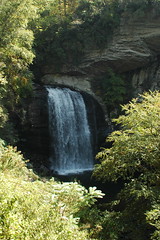 The experimental area, showing the five cleared patches, with two connected by a corridor.
The experimental area, showing the five cleared patches, with two connected by a corridor.
Credit: North Carolina State University
Corridors are a technique intended to allow species to travel between otherwise isolated habitats. A research study, recently published in Science magazine, examined the question of whether or not corridors actually encourage dispersion of species and, if so, the extent of that effect. The abstract describes it this way:
Habitat fragmentation is one of the largest threats to biodiversity. Landscape corridors, which are hypothesized to reduce the negative consequences of fragmentation, have become common features of ecological management plans worldwide. Despite their popularity, there is little evidence documenting the effectiveness of corridors in preserving biodiversity at large scales. Using a large-scale replicated experiment, we showed that habitat patches connected by corridors retain more native plant species than do isolated patches, that this difference increases over time, and that corridors do not promote invasion by exotic species. Our results support the use of corridors in biodiversity conservation.
The study has been widely covered in the press. More information about the methodology and outcomes of the study is available from these reports:
To perform the research, the scientists collaborated with the U.S. Forest Service at the Savannah River Site National Environmental Research Park, a federally protected area on the South Carolina-Georgia border. Most of the Savannah River Site is covered with pine plantations. The U.S. Forest Service created eight identical sites, each with five openings, or patches, by clearing the pine forest. A central patch was connected to one other patch by a 150-meter-long, 25-meter-wide corridor, while three other patches were isolated from the central patch – and each other – by the surrounding forest. The patches are home to many species of plants and animals that prefer open habitats, many [of] which are native to the historical longleaf pine savannas of this region.
You can see these patches in the photo above. The dumbel-shaped opening at the top center of the photograph is the two corridor-connected patches. Over the several years of the study, the number of species in the patches joined by the corridor was greater than in the disconnected patches:
The researchers surveyed all plant species inside connected and unconnected patches from 2000 to 2005; nearly 300 species of plants were found. When the study began, there was no difference in the number of species between connected and unconnected patches, the scientists say. After five years, however, patches with a corridor retained high numbers of species, while those without a corridor lost species.
Corridors provided the largest benefit to native species while having no effect on the number of invasive plant species. Invasive species seem to already be everywhere, not needing corridors for their spread, or remain where they originated, [lead author, Ellen] Damschen says. These results indicate that using corridors in conservation should provide benefits to native species that outweigh the risk of furthering the spread of exotic species.
I see two problems with generalizing the favorable results from this study. First, the study looked at clearings in forests. As the press release notes, the species are those which prefer open regions. These are more likely to be “opportunistic” species adapted to colonizing disturbed areas such as those arising from fires. I would expect such species to “travel” well, since they must locate these open areas before they regain significant woody plant cover.
The second problem I see with generalizing these results is that it’s looking at the wrong kind of corridor. The single greatest threat to biodiversity is habitat loss arising from human activities, such as development, logging, mining, farming, and so on. These activities create the inverse relationship: “patches” of forest or other undisturbed habitat separated, divided, and chopped up by human activities, ie: clearings. The corridors we need, and which ecologists and others strive to implement and preserve, connect forests and other habitats separated by clearings, not clearings separated by forest.
Links:
Original Link (defunct): http://news.ncsu.edu/releases/2006/august/144.html
























